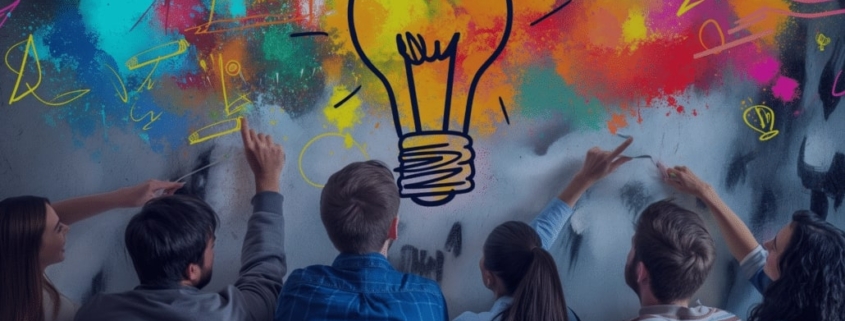The innovator: Fostering creativity in the workplace
Innovation is the key to staying ahead of the competition. Companies that foster creativity within their teams not only drive progress but also cultivate a culture of engagement, collaboration, and continuous improvement. But what makes an employee truly innovative? And how can organizations create an environment that nurtures creativity? As a recruitment agency in Cape Town, we understand that hiring and developing the right talent is crucial for business success. In this article, we explore the traits of innovative employees and provide actionable strategies for fostering creativity in the workplace.
The traits of innovative employees
Not all employees naturally exhibit innovative traits, but organizations can identify and nurture those who do. Recognizing these qualities in employees can help businesses to start fostering creativity in the workplace, problem-solving, and continuous improvement. Here’s a closer look at the key characteristics of innovative employees and how to spot them within your organization:
1. Curiosity and open-mindedness
Innovators are naturally curious individuals who never stop asking questions. They challenge the status quo, seek to understand the “why” behind existing processes, and explore alternative solutions. These employees enjoy learning, experimenting, and discovering new ways to approach tasks.
How to identify them
- They ask insightful questions during meetings and discussions.
- They often bring up new ideas or suggest improvements.
- They show enthusiasm for learning, whether through reading, training, or networking.
How to nurture them
- Encourage continuous learning through training programs, conferences, and mentorship opportunities.
- Create an open culture where employees feel safe questioning existing processes.
- Provide access to knowledge-sharing platforms where employees can explore new topics.
2. Problem-solving ability
Creative employees have a unique ability to analyze challenges from multiple angles and devise effective solutions. They approach problems with a solutions-oriented mindset and see obstacles as opportunities rather than setbacks. These individuals are resourceful and adaptable, making them indispensable to any team.
How to identify them
- They remain calm and proactive when faced with challenges.
- They regularly propose alternative solutions and troubleshoot issues independently.
- They excel in brainstorming sessions and contribute meaningful insights.
How to nurture them
- Encourage employees to take ownership of challenges and think critically.
- Implement collaborative problem-solving workshops to develop creative thinking skills.
- Recognize and reward employees who consistently find innovative solutions.
3. Risk-taking and resilience
Innovation requires stepping outside of comfort zones and experimenting with new ideas—some of which may not always succeed. Risk-taking employees are willing to challenge norms and try unconventional methods. Equally important, they possess resilience, bouncing back from failures with renewed determination.
How to identify them
- They are willing to experiment with new approaches and take calculated risks.
- They handle failure constructively and use setbacks as learning experiences.
- They remain motivated and adaptable even in uncertain situations.
How to nurture them
- Foster a company culture where failures are seen as learning opportunities.
- Provide leadership support and reassurance to employees trying new things.
- Create an environment where employees can share their risk-taking experiences and lessons learned.
4. Strong communication and collaboration skills
Innovation is rarely a solo endeavor—great ideas thrive in environments where employees can effectively share and develop them. Innovative employees communicate their ideas clearly and collaborate well with others, fostering a dynamic exchange of insights and perspectives.
How to identify them
- They actively contribute in team discussions and brainstorming sessions.
- They are receptive to feedback and can articulate their ideas persuasively.
- They enjoy working across departments and engaging with colleagues from different backgrounds.
How to nurture them
- Encourage open dialogue and constructive feedback within teams.
- Use collaborative tools to enhance teamwork and idea-sharing.
- Provide training in communication skills to help employees present their ideas effectively.
5. Passion and drive
Innovators are deeply passionate about their work, which fuels their motivation to bring ideas to life. Their enthusiasm is infectious, inspiring others to think creatively and take initiative. Employees with a strong sense of purpose are more likely to go the extra mile in generating and executing innovative ideas.
How to identify them
- They take pride in their work and often go beyond their basic responsibilities.
- They actively seek new challenges and opportunities to contribute.
- They inspire and energize their colleagues with their enthusiasm.
How to nurture them
- Align their roles with their interests and strengths to maintain motivation.
- Provide opportunities for employees to work on passion projects.
- Recognize and celebrate their contributions to innovation.
Identifying and nurturing innovative employees is essential for businesses looking to drive progress and maintain a competitive edge.
Strategies to encourage creativity in the workplace
Creativity doesn’t happen by chance—it flourishes in environments that actively encourage it. Here are some proven strategies for fostering innovation within your team:
1. Cultivate a culture of psychological safety
Employees are more likely to share their creative ideas when they feel safe and supported. Leaders should create an open and non-judgmental environment where team members feel comfortable expressing new thoughts without fear of criticism or failure. Encouraging constructive feedback and recognizing effort, even when ideas don’t work out, is essential.
2. Encourage diverse perspectives
Diversity fuels creativity. When teams include individuals from different backgrounds, experiences, and areas of expertise, they bring unique viewpoints that spark innovation. Encourage cross-functional collaboration and seek input from employees at all levels.
3. Provide opportunities for continuous learning
Creative employees thrive in environments where they can expand their knowledge and skills. Offer training programs, workshops, and access to new resources to stimulate fresh thinking. Supporting professional development not only enhances creativity but also boosts employee engagement.
4. Give employees autonomy
Micromanagement stifles innovation. Allow employees the freedom to explore new ideas, take initiative, and experiment with solutions. Giving them ownership over their projects fosters accountability and inspires them to think outside the box.
5. Implement brainstorming and idea-sharing sessions
Regular brainstorming sessions encourage employees to think creatively and collaborate on new concepts. Techniques such as mind mapping, design thinking, and “blue sky” sessions can help teams generate innovative solutions. Creating dedicated spaces for idea-sharing, both physically and digitally, can also drive creativity.
6. Reward and recognize creativity
Employees are more likely to contribute innovative ideas when their efforts are acknowledged. Recognizing creative contributions through incentives, promotions, or simple appreciation can motivate employees to continue thinking innovatively. Consider establishing awards for innovative solutions or integrating creativity into performance evaluations.
7. Invest in the right tools and technologies
Equipping employees with the right tools and technology enables them to explore creative solutions more effectively. Whether it’s collaboration software, AI-powered research tools, or design platforms, providing access to innovation-friendly resources can drive productivity and idea generation.
8. Foster a growth mindset
Encourage employees to embrace challenges and view setbacks as learning opportunities. A growth mindset—believing that abilities can be developed through dedication and hard work—creates an atmosphere where employees are motivated to take creative risks and push boundaries.
Embracing innovation for long-term success
By recognizing and nurturing employees who exhibit curiosity, problem-solving abilities, resilience, strong communication skills, and passion, businesses can unlock their teams’ full creative potential and start fostering creativity in the workplace.
However, innovation doesn’t happen in isolation. Organizations must take proactive steps to support creative thinking by encouraging diverse perspectives, providing learning opportunities, and offering employees the freedom to experiment. Leadership plays a crucial role in this process, setting the tone for a culture that values innovation and continuous improvement.
We understand fostering creativity in the workplace is important. If you’re looking to build a team that thrives on creativity and problem-solving, we can help you find and develop employees who will drive your business forward. Visit our website today to explore our expert recruitment and staffing solutions!



